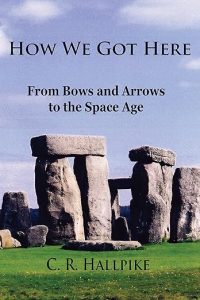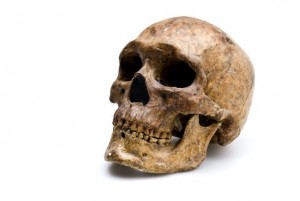C. R. Hallpike, How We Got Here: from bows and arrows to the space age (2008).

Until about 10,000 years ago our ancestors lived in small exogamous groups consisting of 25-50 persons each: men, women and children. Inside each group all members were tied to each other by blood or marriage. All were in daily contact with each other, and all were almost indistinguishable in terms of wealth of which, in case, case, there was only as much as peo0le could carry or preserve. Having long mastered fire and learnt to cook food, and armed with stone tools as well as wooden spears and bows and arrows, they roamed over what, to them, must have looked like almost limitless space. As a result, except under exceptional circumstances such as droughts and the like, most of the time they had enough, not seldom even more than enough, to eat. The same factor, i.e the abundance of available space, prevented warfare from doing serious, long-time harm to those who engaged in it. The more so because the normal objective was prestige and revenge, not extermination or permanent subjugation. The last of which, given the way these societies were structured, was impossible to establish in any case.
Fast forward to the early years of the twenty-first century. Our numbers, which 7,000 years ago are said to have reached perhaps 5 million people, have increased to the point where the earth’s population is around 8 billion and growing still. Practically all of them live in millions-strong states where only a very small percentage are related by bloodlines and/or have personal knowledge of each other except, perhaps, in the form of sounds and images emitted by some piece of electronic wizardry. Far from our wealth being equally—let alone, equitably—distributed, we range from penniless beggars always on the verge of starvation to the likes of Jeff Bezos and Elon Musk. In terms of the technology at our disposal we have reached the point where we are now actively drawing up plans for colonizing not just the moon but Mars as well. All this within what in evolutionary terms, let alone geological ones, amounts to a mere blink of an eye.
How could it, how did it, happen? This is the question that Christopher Hallpike, a long retired Canadian professor anthropology who at one point moved to Oxford, took it upon himself to answer. Not that he is the first to do so. One is reminded of the Jacob Bronowski’s The Ascent of Man (TV series, 1973), Bill Bryson’s Short History of Nearly Everything (2003), and Yuval Harari’s Sapiens (2011), among many others. Equating cultural development with biological evolution, almost all of them drew on Darwin as their source of inspiration. With him in mind, almost all started with two basic ideas. First, that cultural change—mutation, to use the language of evolutionists—is more or less accidental, taking place spontaneously now here, now there. Second, that whether or not any innovation persists and spreads depends on how useful it is—the extent to which it makes those who are in charge of it, more comfortable, more powerful and, last not least, wealthier.
By contrast, Professor Hallpike takes it as his starting point that human development, aka culture is not blind. True, some minor changes may have come about more or less by accident. However, he says, for them to persist and to spread there is a need for a conscious effort on the part of both originators and beneficiaries. First, it requires the kind of mind needed to contemplate a new and different reality—precisely the one that, as far as we can see, animals ranging from mosquitos to chimpanzees do not possess. Second, it requires an open society in which different people, coming from different directions and possessing different skills, can meet, exchange ideas, cooperate and, where necessary criticize each other. Third, it requires an investment. If not of money, which only appeared around 600-700 BCE, long after some of the most important discoveries and inventions were made, then at any rate of time and effort. Very often, and this is a point that Hallpike does not emphasize as much as he could and perhaps should have, it also involves taking a risk. The story of the monk Berthold Schwarz inventing gunpowder and being blown up for his pains may not be rooted in fact. Nevertheless, it does present people with a “lesson learnt.”
Another basic point with which Hallpike takes issue is the common belief, famously caricatured by Charles Dickens and his infamous creation Mr. Gradgrind, that it is only material “facts” that either cause change or are affected by it. Standing in front of the blackboard—after all, Gradgrind is a teacher—swish, and away goes religion. Swish, and away goes our senses of beauty, of order, of awe in face of the mysterious and the unknown. Swish, and away go curiosity and inspiration. Swish… Never, so Hallpike, has there been a human society which did not have all those things. Judging by the expression on the face of my cat when he first discovered a new opening we had made in a kitchen wall, even many animals experience some of them.
Finally, judging by his books, including some of his (very funny) fiction I have read, I trust that Hallpike would not have been the man he evidently is, i.e one who loves to play devil’s advocate, if he had overlooked the greatest provocation of all: namely the idea of distinguishing “primitive” from “modern” man. Had he not been long retired, no doubt that alone would have brought on his head severe sanctions on the part of the politically correct thought-control mob. In fact, though, his use of the term is perfectly reasonable. Lacking as they did modern, observation-experimental-mathematically based science, our pre-literate ancestors perforce had no choice but to base much of their understanding of the world on folk wisdom much of which in turn rested on symbolism, religion, magic and intuition as well as every kind of contrast or affinity, real or imagined. It is in this sense, and in this sense alone, that Hallpike calls people and the societies they formed “primitive.” But not once in some 650 pages does he suggest that they were mentally retarded.
I cannot end this essay without noting two other points. First, as an anthropologist who has spent some years living with some of the “primitive” societies he mentions—first in East Africa, then in Papua-New Guinea—Hallpike, discussing such societies, has the immense advantage of knowing exactly what he is talking about. This alone is a good reason for taking what he has to say about them seriously. Second, I find his knowledge of societies, material objects and processes truly incredible; starting with metallurgy—and ending with the history of the alphabet, mathematical notation, alchemy, government, warfare, philosophy, monotheism, astrology and the scientific method there is hardly any field about which he does not have something interesting to say.
The book’s title notwithstanding, its journey through history ends about 1914. As a result, subsequent developments such as relativity, quantum mechanics and chaos theory are mentioned barely if at all. That is a pity; could anyone come up with better examples of sheer curiosity, rather than material gain, driving history into new and unexpected directions? Still I stand amazed. And also, I confess, a little jealous in front of so much knowledge so engagingly presented.


